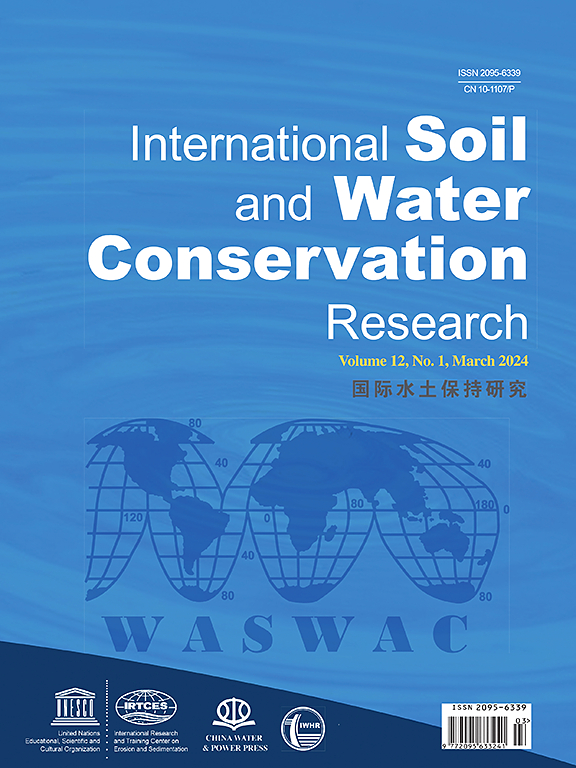Response of soil detachment capacity to freeze‒thaw process for five loess soils from the Loess Plateau of China
IF 7.3
1区 农林科学
Q1 ENVIRONMENTAL SCIENCES
International Soil and Water Conservation Research
Pub Date : 2025-05-22
DOI:10.1016/j.iswcr.2025.05.008
引用次数: 0
Abstract
The combined effects of freeze-thaw and water erosion significantly increase the risk of soil erosion in seasonally freeze-thaw regions. Although soil detachment capacity (SDC) is a critical parameter for evaluating soil erosion degree, the effect of freeze-thaw cycles (FTC) on SDC is not comprehensively understood. Therefore, experiments were conducted in a scouring flume under six freeze-thaw cycles (i.e., 0, 1, 5, 10, 15, and 20 FTC), five flow discharges (2−18 L min−1), and five soil types. The results showed that FTC caused varying degrees of degradation in soil properties, leading to variations in SDC. Under different initial moisture contents, SDC exhibited an increasing trend during the initial stages of FTC and stabilized after 10 FTC. Compared with unfrozen soil, under different freeze-thaw levels (1−20 FTC), the mean SDC of Wuzhong soil, Shenmu soil, Ansai soil, Dingxi soil, and Changwu soil increased by 27, 30, 25, 38, and 57 %, respectively. Apart from porosity, SDC showed notable inverse correlations with other soil properties, including cohesion, shear strength, internal friction angle, organic matter, and bulk density (p < 0.05). Stream power was identified as the ideal hydrodynamic parameter for characterizing SDC (R2 = 0.85). An SDC prediction model was established according to these key factors. The model effectively predicted the SDC under the synergistic action of flow and freeze-thaw (R2 = 0.90, RE = −9.02 %). Additional verification is necessary when applying the predictive model outside the conditions under which it was developed. The findings contribute novel understanding into the operational mechanism of soil detachment in freeze-thaw affected regions.
黄土高原5种黄土土壤分离能力对冻融过程的响应
冻融和水侵蚀的共同作用显著增加了季节性冻融地区土壤侵蚀的风险。土壤剥离能力(SDC)是评价土壤侵蚀程度的重要参数,但冻融循环对土壤剥离能力的影响尚不全面。因此,在冲刷水槽中进行了6次冻融循环(即0、1、5、10、15和20 FTC)、5种流量(2 - 18 L min - 1)和5种土壤类型的实验。结果表明,FTC对土壤性质造成不同程度的退化,从而导致SDC的变化。不同初始含水率下,SDC在FTC初期呈上升趋势,在FTC 10后趋于稳定。在不同冻融水平(1 ~ 20 FTC)下,吴中土、神木土、安塞土、定西土和长武土的平均SDC分别比未冻融土高27%、30%、25%、38%和57%。除孔隙度外,SDC与土壤黏聚力、抗剪强度、内摩擦角、有机质、容重等其他性状呈显著负相关(p < 0.05)。水流功率被认为是表征SDC的理想水动力参数(R2 = 0.85)。根据这些关键因素建立了SDC预测模型。该模型有效预测了冻融与流动协同作用下的SDC (R2 = 0.90, RE =−9.02%)。在开发预测模型的条件之外应用预测模型时,需要进行额外的验证。研究结果有助于对冻融影响地区土壤分离的作用机制有新的认识。
本文章由计算机程序翻译,如有差异,请以英文原文为准。
求助全文
约1分钟内获得全文
求助全文
来源期刊

International Soil and Water Conservation Research
Agricultural and Biological Sciences-Agronomy and Crop Science
CiteScore
12.00
自引率
3.10%
发文量
171
审稿时长
49 days
期刊介绍:
The International Soil and Water Conservation Research (ISWCR), the official journal of World Association of Soil and Water Conservation (WASWAC) http://www.waswac.org, is a multidisciplinary journal of soil and water conservation research, practice, policy, and perspectives. It aims to disseminate new knowledge and promote the practice of soil and water conservation.
The scope of International Soil and Water Conservation Research includes research, strategies, and technologies for prediction, prevention, and protection of soil and water resources. It deals with identification, characterization, and modeling; dynamic monitoring and evaluation; assessment and management of conservation practice and creation and implementation of quality standards.
Examples of appropriate topical areas include (but are not limited to):
• Conservation models, tools, and technologies
• Conservation agricultural
• Soil health resources, indicators, assessment, and management
• Land degradation
• Sustainable development
• Soil erosion and its control
• Soil erosion processes
• Water resources assessment and management
• Watershed management
• Soil erosion models
• Literature review on topics related soil and water conservation research
 求助内容:
求助内容: 应助结果提醒方式:
应助结果提醒方式:


